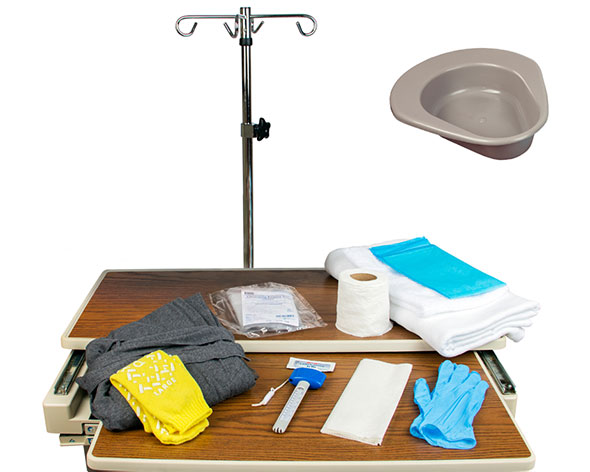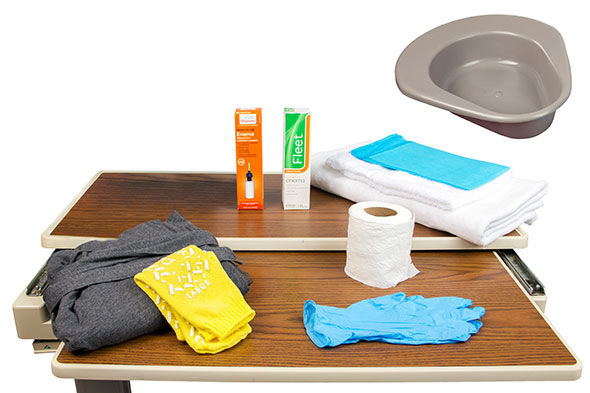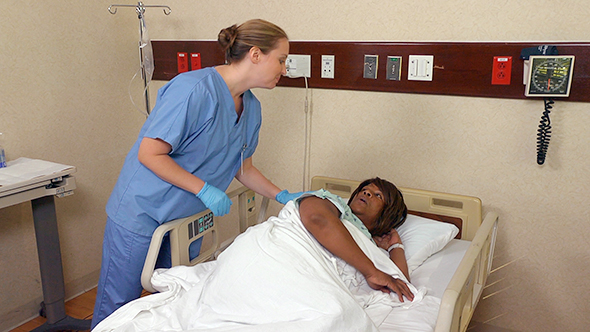Elimination Assistance
Select a Skill:
- » Helping the Person to the Commode
- » Applying Incontinence Products
- » Giving the Urinal
- » Giving the Bedpan
- » Applying a Condom Catheter
- » Giving Catheter Care
- » Emptying a Urinary Drainage Bag
- » Changing a Leg Bag to a Drainage Bag
- » Giving an Enema
- » Changing an Ostomy Pouch
Take the Review Test:

Purpose

- An enema is the introduction of fluid into the rectum and lower colon. Doctors order enemas to:
- Remove feces.
- Relieve constipation, fecal impaction, or flatulence.
- Clean the bowel of feces before certain surgeries and diagnostic tests.
- The doctor orders the enema solution. The solution depends on the enema’s purpose—for cleansing, constipation, fecal impaction, or flatulence.
- Small-volume enema—the adult size contains about 120 mL (4 oz) of solution.
- Oil-retention enema—has mineral, olive, or cottonseed oil. The adult size contains about 120 mL (4 oz) of solution.
- Tap water enema—is obtained from a faucet.
- Saline enema—a solution of salt and water. For adults, add 1 to 2 teaspoons of table salt to 500 to 1,000 mL of tap water.
- Soapsuds enema (SSE)—for adults, add 3 to 5 mL of castile soap to 500 to 1,000 mL of tap water.
- Small-volume enemas cause a bowel movement (BM). They are often ordered for constipation or when the bowel does not need complete cleansing. They are ready to give. The solution is usually given at room temperature. Urge the person to retain the solution until he or she needs to have a BM.
- Oil-retention enemas relieve constipation and fecal impaction. Most oil-retention enemas are commercially prepared.
- Cleansing enemas (tap water, saline, and soapsuds enemas) clean the bowel of feces and flatus. They relieve constipation and fecal impaction and are needed before certain surgeries and diagnostic tests. If "enemas until clear" is ordered, give enemas until the return solution is clear and free of stools. Ask the nurse how many to give.
Equipment
Roll cursor over items to see labels. For the purposes of clearly depicting the equipment, a barrier is not shown in this photo. When providing care, a barrier should always be placed on the surface before placing the equipment.
Scroll down to see all equipment images.

IV (intravenous) pole
Bath blanket
Bedpan
Disposable enema kit (enema bag, tube, clamp, and waterproof pad)
Toilet tissue
Waterproof pad, if not in the enema kit
Gloves
Paper towels
Bath thermometer
Water-soluble lubricant
Robe and non-skid footwear

Bedpan
Small-volume enema
Water-soluble lubricant
Bath blanket
Waterproof pad, if not in the enema kit
Toilet tissue
Gloves
Robe and non-skid footwear
Delegation
- Before giving an enema, make sure that:
- Your state allows you to perform the procedure.
- The procedure is in your job description.
- You have the necessary education and training.
- You review the procedure with a nurse.
- A nurse is available to answer questions and to supervise you.
- Follow delegation guidelines. Before giving an enema, obtain this information from the nurse and care plan:
- What type of enema to give—small-volume, oil-retention, or cleansing
- What size enema tube to use
- What lubricant to use
- When to give the enema
- How many times to repeat the enema
- The amount of solution ordered—usually 500 to 1,000 mL for a cleansing enema (for adults)
- How much castile soap to use for an SSE or salt to use for a saline enema
- What temperature the solution should be—usually 98.6˚F (37.0˚C); sometimes warmer temperatures (105˚F [40.5˚C]) are used for adults
- How to position the person—the Sims’ or left side-lying position
- How far to insert the enema tubing—usually 2 to 4 inches above the anus
- How fast to give the solution—750 to 1,000 mL are usually given over 10 to 15 minutes
- How long the person should try to retain the solution
- What observations to report and record
- When to report observations
- What patient or resident concerns to report at once
Preparation

- Observe quality-of-life measures.
- Review the information under Delegation and Safety and Comfort.
- Practice hand hygiene.
- Collect the equipment from the list, down to gloves.
- Arrange items in the person’s room and bathroom.
- Practice hand hygiene.
- Identify the person. Check the ID bracelet against the assignment sheet. Also call the person by name.
- Put on gloves.
- Collect the remaining equipment on the list.
- Remove and discard the gloves. Practice hand hygiene. Put on clean gloves.
- Provide for privacy.
- Raise the bed for body mechanics. Bed rails are up if used.
Safety

- Enemas are usually safe procedures. Many people give themselves enemas at home. However, enemas are dangerous for older persons and those with certain heart and kidney diseases.
- The oil-retention enema is retained for at least 30 to 60 minutes. Leave the room after giving the enema. Check on the person often. After checking on the person, tell him or her when you will return. Remind the person to signal for you if he or she needs help. Report any problems at once.
- Contact with stools is likely when giving enemas. Stools contain microbes and may contain blood. Follow Standard Precautions and the Bloodborne Pathogen Standard.
Comfort
- Have the person void first. This increases comfort during the enema procedure.
- Before starting the procedure, make sure the bathroom is ready for the person’s use. If the person will use the commode or bedpan, have the device ready. Always keep a bedpan nearby in case the person starts to expel the enema solution and stools. Mental comfort is promoted when the person knows the bathroom, commode, or bedpan is ready for use.
- The person needs to retain the solution as long as possible. Make sure the person is comfortable in the Sims’ or left side-lying position. When comfortable, it is easier to tolerate the procedure.
- To prevent cramping, use the correct water temperature. (Cool water causes cramping.) Also give the solution slowly.
Procedure Video
Audio Description: OFFFollow-up Care

- Provide for comfort.
- Place the call light within reach.
- Lower the bed to its lowest position. Raise or lower bed rails. Follow the care plan.
- Unscreen the person.
- Complete a safety check of the room.
- Follow agency policy for dirty linens and used supplies.
- Practice hand hygiene.
Reporting/Recording
- Report and record your observations, including:
- The amount of solution given
- If you noted bleeding or resistance when inserting the tube
- How long the person retained the enema solution
- Color, amount, consistency, shape, and odor of stools
- Complaints of cramping, pain, discomfort, nausea, or weakness
- How the person tolerated the procedure
Review Questions
Select the best answer.
1. What is an enema?
 The introduction of fluid into the rectum
The introduction of fluid into the rectum The use of an oral solution to relieve constipation
The use of an oral solution to relieve constipation A medication used to treat hemorrhoids and rectal pain
A medication used to treat hemorrhoids and rectal pain A surgical opening on the abdomen that lets stool exit the body
A surgical opening on the abdomen that lets stool exit the body
Select the best answer.
2. Why may an enema be ordered?
 To assist in weight loss
To assist in weight loss To treat rectal discomfort
To treat rectal discomfort To treat nausea and vomiting
To treat nausea and vomiting To relieve constipation or flatulence
To relieve constipation or flatulence
Select the best answer.
3. Which type of enema is used to prepare the bowel for surgery or a diagnostic test?
Select the best answer.
4. When giving an enema, which action is appropriate?
 Administer the enema solution quickly for the best results.
Administer the enema solution quickly for the best results. Use tap water only when giving an enema to an infant or child.
Use tap water only when giving an enema to an infant or child. Make sure that the call light is within the person’s reach after enema administration.
Make sure that the call light is within the person’s reach after enema administration. Raise the container if the person has cramping or if fluid escapes around the rectal tube.
Raise the container if the person has cramping or if fluid escapes around the rectal tube.
Select the best answer.
5. How should you position the person for an enema?
 On the right side with both knees bent
On the right side with both knees bent On the abdomen with the legs straight
On the abdomen with the legs straight On the left side with the right knee bent
On the left side with the right knee bent On the back with the knees bent and spread apart
On the back with the knees bent and spread apart
You have completed the Review Questions for this skill. To take the Review again select the Start Over button. To proceed to another skill select from the dropdown menu. Select the Home or Back button to proceed to the next section.

